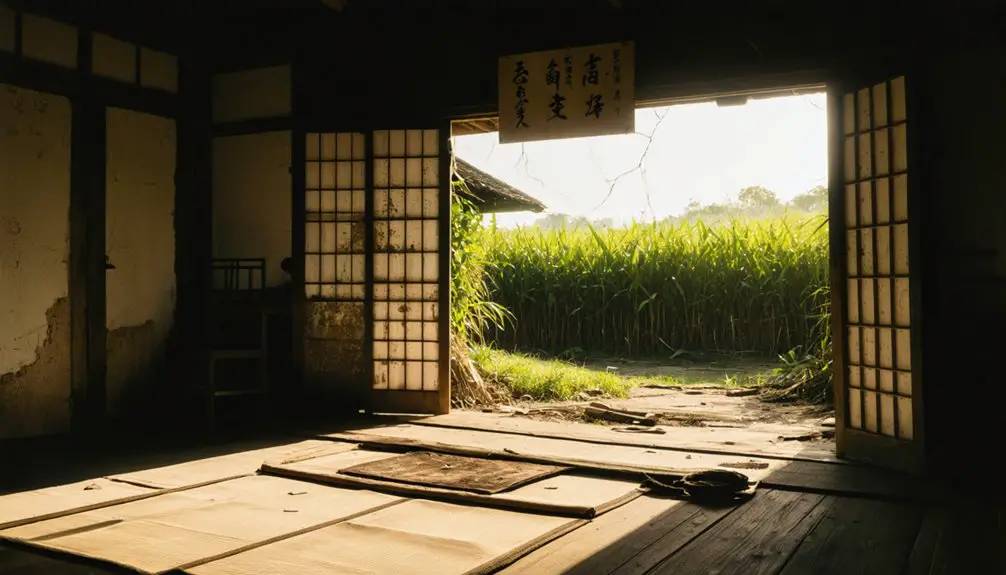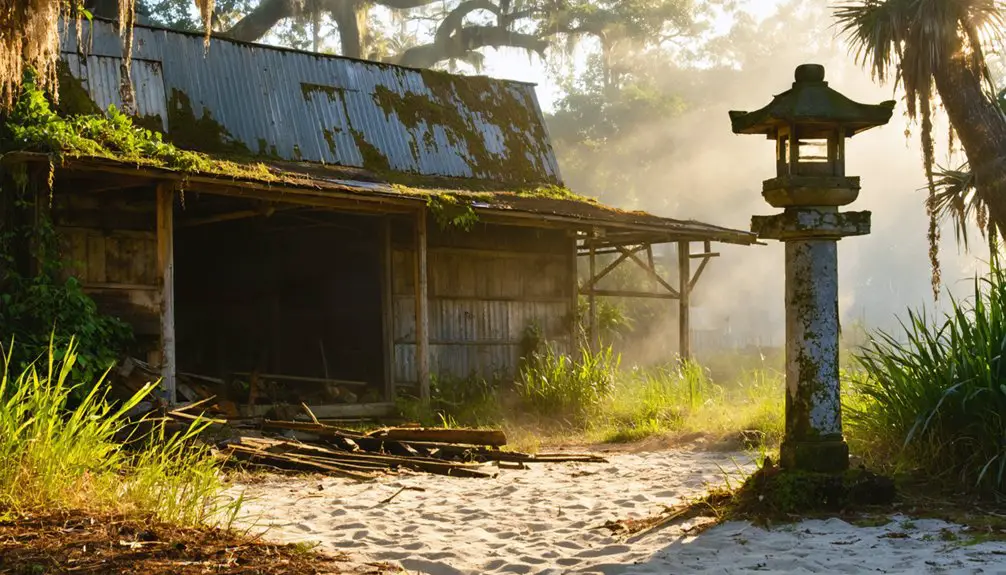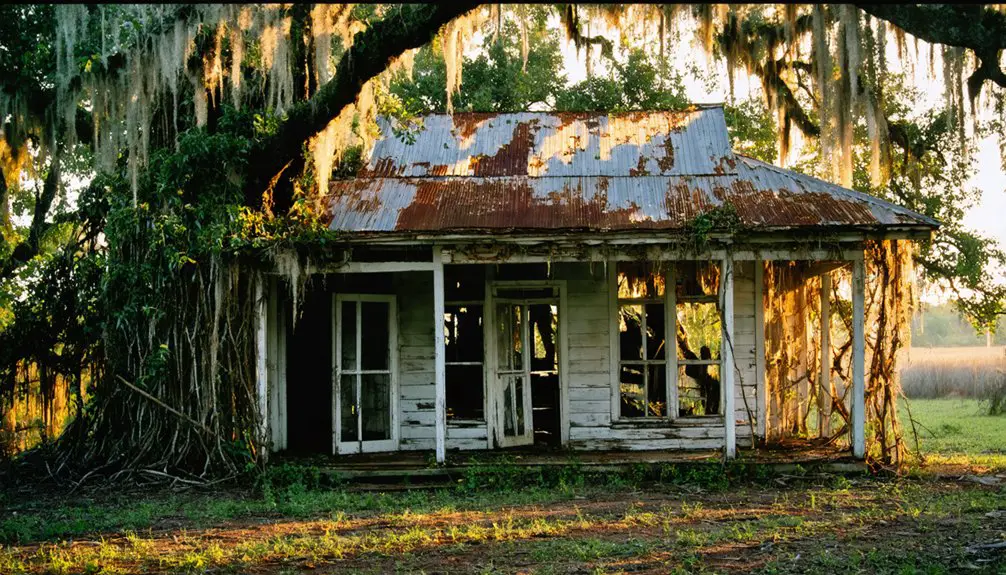You’ll find the remnants of Yamato Colony, a pioneering Japanese settlement established in 1903 by Jo Sakai, beneath modern Florida developments. The colony transformed 1,000 acres of swampland into farmland, initially focusing on pineapple cultivation before diversifying into vegetables. World War II forced the displacement of Japanese residents, effectively ending the community. Today, the Morikami Museum and Japanese Gardens stand as a testament to this remarkable cultural experiment, preserving stories that illuminate Florida’s multicultural past.
Key Takeaways
- Yamato Colony, established in 1903, transformed from a thriving Japanese agricultural settlement into an abandoned site following World War II.
- Military acquisition during WWII forcibly displaced the remaining Japanese residents, leading to the community’s complete dissolution.
- The former colony site now houses the Morikami Museum, preserving the settlement’s history through exhibitions and Japanese gardens.
- Urban development and rising property values erased most physical traces of the original Yamato Colony settlement.
- The colony’s population declined from forty residents in 1908 to virtual abandonment by the 1940s due to economic hardships.
The Vision of Jo Sakai: A Japanese Settlement in Florida
In 1903, Jo Sakai commenced an ambitious venture to establish a Japanese agricultural settlement in Florida, drawing upon his samurai heritage and American education to bridge two cultures. His vision centered on creating a thriving community that would maintain its cultural identity while pioneering agricultural innovation in the American South.
You’ll find that Sakai’s strategic approach involved carefully building alliances with Florida’s power brokers, including Governor William Jennings and business leader James Ingraham.
After selecting Boca Raton as the colony’s location, he named it “Yamato,” connecting the settlers to their Japanese roots. Despite the challenging terrain of swampy land and harsh conditions, Sakai recruited over 20 young men from Japan, emphasizing the importance of family life and community stability in establishing a lasting agricultural settlement. Initial farming efforts focused on growing pineapple crops, though settlers later had to diversify due to market competition. Following his marriage to Sada Kawashima, Sakai established a family of five daughters while leading the colony’s development.
From Swampland to Agricultural Dreams
When the first Japanese settlers arrived at the Yamato Colony site, they encountered an unnavigable swampland that would test their determination and agricultural ingenuity. You can imagine their agricultural challenges as they drained the mosquito-infested terrain and battled Florida’s oppressive heat to transform virgin land into farmable soil.
The community’s resilience shone through their adaptability. While initial experiments with tea, silk, and rice failed due to unsuitable conditions, they didn’t surrender. Instead, they embraced local knowledge from African American and Bahamian workers, mastering subtropical farming techniques. Under Jo Sakai’s leadership, the colony found success by shifting to pineapple farming operations. Unfortunately, their success was short-lived when crop blight devastated their pineapple harvests.
Building a Community: Life in Early Yamato
Though Jo Sakai envisioned Yamato as a self-sustained Japanese village, the colony’s social fabric wove together diverse cultural threads.
You’d find Japanese families maintaining their heritage through communal activities like traditional baths, hanafuda card games, and miso-making, while adapting to their new Florida home.
The settlement’s infrastructure reflected this cultural bridge: a schoolhouse where explorer Laurence Gould taught local children, the Kamiya family’s convenience store serving both Japanese and American customers, and a post office connecting residents to the wider world.
The enterprising farmers initially focused on cultivating rice and pineapples as their primary crops.
Cultural preservation remained strong as settlers wore kimonos for special occasions and celebrated traditional festivals, even as their children attended Delray Beach schools.
By 1908, the colony reached its peak with forty residents including the first female settler.
The community’s strength lay in its ability to honor Japanese traditions while embracing their American surroundings.
Pineapples and Perseverance: Farming the Florida Sand
As Yamato’s settlers faced Florida’s inhospitable sandy soil, they quickly discovered that their dreams of traditional Japanese agriculture wouldn’t translate to this new environment.
You’d find them turning to pineapple cultivation, establishing over 42 acres by 1908, and shipping their harvest north via the Florida East Coast Railroad.
When Cuban imports threatened their pineapple profits, these resilient farmers didn’t surrender. Instead, they embraced agricultural innovation, learning from local African American and Bahamian workers who understood Florida’s challenging terrain. Henry Flagler’s company had initially invited the Japanese immigrants to establish this farming community.
Their experimentation yielded success with vegetables like tomatoes, peppers, and eggplants. Through fierce heat, mosquitoes, and unforgiving sand, the settlers persisted, transforming swampland into productive fields. Among them was Morikami Sukeji, who arrived at age 19 and worked through language barriers to master farming techniques.
Though many were educated men unused to farm labor, they adapted, blending Japanese agricultural knowledge with subtropical farming techniques.
Cultural Fusion: Japanese Traditions Meet American Soil
The Yamato settlers’ remarkable cultural fusion began with the establishment of their self-governing colony in 1904, where Japanese traditions merged seamlessly with American agricultural practices.
You’ll find their cultural adaptations evident in their innovative approach to farming. While they initially attempted familiar Japanese crops like rice and tea, they quickly pivoted to successful Florida crops such as pineapples and citrus. Their agricultural innovations blended Japanese expertise with American market systems, utilizing the Florida East Coast Railroad for distribution.
The colony’s social fabric wove together Japanese and American elements. Through the Yamato Colony Association, they maintained traditional governance while adapting to American frameworks.
The Yamato Colony skillfully balanced Japanese cultural preservation with American integration, creating a harmonious blend of Eastern and Western social structures.
They preserved customs through Japanese marriage practices while fostering relationships with local African American and Bahamian workers, creating a unique cross-cultural exchange in early 20th century Florida.
Daily Challenges in the Subtropical Paradise
You’ll find the Yamato colonists faced relentless daily battles against mosquito swarms and tropical diseases, forcing them to wear protective head-nets while working their fields in the sweltering heat.
Your historical understanding deepens when you consider how these pioneering farmers contended with venomous snakes and dangerous alligators lurking in the surrounding wetlands.
The settlers’ resilience was further tested by the constant threat of seasonal flooding and devastating tropical storms that could destroy months of agricultural progress in a matter of hours. These determined Japanese settlers established their unique agricultural community in the early twentieth century, bringing new farming techniques to Palm Beach County. The project, founded by Jo Sakai in 1904, aimed to create a thriving farming colony in South Florida’s challenging environment.
Mosquitoes and Tropical Disease
Living in Yamato Colony meant contending with Florida’s diverse and aggressive mosquito populations, which posed severe health risks to the settlement’s inhabitants.
You’d find yourself battling multiple species, from the urban-dwelling Aedes aegypti with its distinctive violin markings to the striped Asian Tiger mosquito. Salt marsh mosquitoes would sweep in from nearby mangroves and coastal areas, capable of flying long distances to reach the colony.
Disease prevention became a daily struggle as these insects transmitted serious illnesses like dengue, yellow fever, and various forms of encephalitis.
The subtropical climate created perfect breeding conditions in standing water, from discarded containers to flooded soil. Effective mosquito control required constant vigilance – eliminating standing water, maintaining screens, and protecting yourself during both day and night.
Battling Wild Florida Animals
Three major categories of wild animals posed daily challenges for Yamato Colony settlers: invasive species, native predators, and dangerous reptiles.
You’d encounter Burmese pythons and wild hogs wreaking havoc on local ecosystems, with hogs destroying crops through aggressive rooting behavior. Florida’s native predators, including panthers and black bears weighing up to 400 pounds, required constant vigilance during wildlife encounters, especially during breeding seasons.
Your most frequent threats came from reptilian predators. American alligators patrolled freshwater areas, while venomous snakes posed hidden dangers in the subtropical environment.
You’d need to exercise particular caution near water bodies, where bull sharks frequently patrolled Florida’s coastal waters. These diverse wildlife challenges demanded careful navigation of both land and water throughout the colony’s territory.
Seasonal Floods and Storms
While the Yamato Colony faced numerous agricultural challenges, seasonal flooding proved to be one of its most relentless adversaries. You’d have found your fields submerged for extended periods, particularly during the summer rainy season when swampland overflow and coastal waters converged on your property.
Even your best flood management efforts couldn’t fully protect against Mother Nature’s fury. From June through November, you’d brace yourself for hurricanes and tropical storms that dropped more than a foot of rain in single events.
Your storm preparedness had to account for both immediate threats and long-term consequences: waterlogged soil that delayed planting, erosion that stripped away precious topsoil, and persistent humidity that bred mosquitoes and disease.
Daily farming operations became a constant battle against the elements.
The Great Depression’s Impact on Colony Life
As the Great Depression gripped America in the 1930s, the Yamato Colony faced devastating economic challenges that accelerated its decline.
You’ll find their community resilience tested as financial institutions denied loans due to anti-Japanese sentiment, while crop failures and falling market prices pushed many farmers to the brink.
- The colony’s population dwindled to just 30 farmers by the 1930s, with many having sold their land during the 1920s Florida land boom.
- Economic adaptation became essential as farmers switched from pineapples to tomatoes and winter vegetables.
- Most colonists lost their land due to unpaid taxes, though George Morikami managed to rebuild.
- The colony’s isolation deepened as younger generations moved away and community infrastructure crumbled.
Despite these hardships, their agricultural legacy lived on through Morikami’s later success and the eventual museum bearing his name.
World War II and the Forced Displacement

Following Japan’s attack on Pearl Harbor, you’ll find that Florida’s Japanese residents, including Yamato’s remaining families, were suddenly classified as “enemy aliens” and faced frozen assets alongside severe movement restrictions.
Within months, the War Department seized nearly 300 acres of Yamato Colony land, forcibly displacing farmers like the Kobayashis and Kamiyas from their properties to establish the Boca Raton Air Field.
While some Yamato residents relocated to the West Coast where they encountered internment camps, such as Oscar Kobayashi’s family at Utah’s Topaz camp and Henry Kamiya at California’s Manzanar, others remained in Florida under strict governmental surveillance and economic limitations.
Pearl Harbor’s Immediate Impact
The Japanese attack on Pearl Harbor in December 1941 triggered devastating consequences for Yamato Colony’s remaining Japanese-American residents.
You’ll find that within days of the attack, the U.S. government implemented severe restrictions that crippled the community’s ability to function:
- The government immediately froze assets belonging to Japanese residents, including those of prominent community members George Morikami and Henry Kamiya.
- Officials classified many residents as “enemy aliens,” restricting their movements and requiring written permission to cross county lines.
- Access to essential farming supplies like seeds and fertilizer was cut off, effectively strangling the colony’s agricultural operations.
- Racial hostility intensified as Japanese Americans became scapegoats, leading some families to relocate voluntarily before facing forced displacement.
Property Seizure and Eviction
While Pearl Harbor’s aftermath brought immediate restrictions, the most devastating blow to Yamato Colony came through widespread property seizures and forced evictions beginning in 1941.
The U.S. government confiscated over 6,000 acres of land to establish an Army Air Corps training base, effectively ending the community’s agricultural innovation and decades of farming expertise.
You’ll find that despite their community resilience, families faced severe displacement as eviction notices appeared on homes throughout the colony.
The government froze assets of Japanese residents like George Morikami and Henry Kamiya, while restricting their movement across county lines.
The seized land, now home to Boca Raton Airport and Florida Atlantic University, represents the erasure of a pioneering farming settlement.
Even U.S.-born children of Japanese immigrants, though facing fewer restrictions, couldn’t prevent their community’s dismantling.
Internment Camp Life Begins
Mass incarceration of Japanese Americans commenced in February 1942 when President Franklin D. Roosevelt issued Executive Order 9066, leading to the displacement of over 110,000 people. The internment experiences that followed would forever change their lives and shape American history.
- You’d find yourself living in spartan conditions with inadequate housing, poor sanitation, and limited food supplies, leading to widespread health issues among internees.
- Your family might be separated, with members scattered across different camps, creating emotional trauma that would span generations.
- Despite harsh conditions, you’d witness remarkable community resilience as internees preserved their cultural heritage through art and literature.
- You’d face significant economic hardship after being forced to abandon your property, businesses, and possessions with little to no compensation.
Morikami’s Gift: Preserving the Colony’s Memory

Following years of decline in the Yamato Colony, George Sukeji Morikami made a transformative decision in 1974 by donating nearly 200 acres of his land to Palm Beach County. His vision extended beyond mere land preservation – he sought to create a lasting bridge between Japanese and American cultural heritage, honoring the innovative farming techniques and determination of the original Yamato settlers.
You’ll find his legacy alive today at the Morikami Museum and Japanese Gardens, which opened in 1977. The complex includes the original Yamato-kan building and a museum expansion completed in 1993.
As the only U.S. museum dedicated to Japanese living culture, it hosts traditional events like Obon and serves as an educational center where you can explore the inspiring story of Japanese pioneers who dared to forge new lives in Florida.
The Lost Town’s Modern Footprint
Today, you’ll find few physical traces of the original Yamato Colony, as modern urban development and World War II military installations transformed the agricultural settlement into Boca Raton’s contemporary landscape.
You can still drive down Yamato Road, a main thoroughfare that carries the colony’s name, leading to the Morikami Museum and Japanese Gardens where George Morikami’s gift of land preserves the settlement’s legacy.
The museum’s authentic Japanese architecture, historical archives, and cultural programming guarantee that while the original ghost town has vanished, its significance endures through carefully curated exhibitions and educational initiatives.
Modern Development Overtakes History
The rapid urbanization of South Florida transformed the once-pastoral Yamato Colony into an unrecognizable landscape of suburban developments and commercial districts.
As urban sprawl consumed the original farmlands, you’ll find little trace of the Japanese agricultural settlement that once defined this area.
- Modern roadways and infrastructure now crisscross former colony lands, with only Yamato Road preserving the name.
- Real estate development and tourism investments replaced traditional farming operations.
- Rising property values incentivized farmers to sell their agricultural plots.
- Cultural erasure accelerated as new construction prioritized contemporary needs over historical preservation.
Today, you’ll see the Morikami Museum standing as the primary physical reminder of this vanished community, while surrounding developments continue to reshape the terrain that once sustained the colony’s farming dreams.
Preserving Through Morikami Museum
Despite the widespread urban development, one remarkable institution stands as a living tribute to the Yamato Colony’s legacy.
The Morikami Museum, founded in 1977 on land donated by George Sukeji Morikami, preserves the settlement’s pioneering spirit through cultural exhibitions and historical artifacts. You’ll find the museum’s architecture thoughtfully designed to reflect Japanese heritage, with its Yamato-kan building modeled after Kyoto’s Katsura Imperial Villa.
Through digitized archives, documentary films, and interactive displays, you can explore the daily lives and agricultural practices of the original settlers.
The museum’s internationally acclaimed gardens, designed by Hoichi Kurisu, create an authentic Japanese cultural experience. This institution serves as more than a memorial – it’s an active bridge connecting you to the remarkable story of Japanese immigrants who shaped Palm Beach County’s early development.
Frequently Asked Questions
How Many Japanese Settlers Originally Came to Establish the Yamato Colony?
You’ll find that Japanese immigration to Yamato began with five settlers in 1904, growing to about 20 young men who launched the agriculture settlement, though numbers later expanded to 17 families.
What Happened to Jo Sakai After the Colony’s Forced Displacement?
Like a fading star, Jo Sakai’s legacy couldn’t be impacted by the colony’s forced displacement – he’d already died in 1923 from tuberculosis in Asheville, NC, decades before wartime pressures shattered Yamato memories.
Did Any Yamato Colony Residents Return to Japan Before World War II?
You won’t find evidence of Japanese repatriation before WWII among Yamato colonists. Their permanent settlement goals, visa restrictions, and established Florida roots contributed to the Yamato legacy of continuous American residency.
Were There Any Marriages Between Yamato Colonists and Local Florida Residents?
You won’t find documented evidence of cultural exchange through interracial marriage between Yamato colonists and local Floridians, as strict social barriers and discriminatory laws of that era effectively prevented such unions.
What Traditional Japanese Festivals or Ceremonies Were Celebrated in Yamato Colony?
Like posting Instagram stories, you’d see colonists celebrate Shogatsu (New Year’s) with family gatherings at Yamato Rocks beach, while matsuri celebrations, tea ceremonies, and traditional Shinto rituals preserved their cultural heritage.
References
- https://delraybeachhistory.org/blog/celebrating-aapi-heritage-month-the-history-of-the-yamato-colony/
- https://discovernikkei.org/en/journal/2020/6/22/yamato-colony/
- https://www.thesmartset.com/article04281001/
- https://morikami.org/yamato-colony/
- https://www.ghosttowns.com/states/fl/yamatocolony.html
- https://morikami.org/about/
- https://www.moas.org/VIRTUAL-Florida-Vistas-Book-Club–Yamato-Colony–The-Pioneers-Who-Brought-Japan-to-Florida-7-8055.html
- https://en.wikipedia.org/wiki/Yamato_Colony
- https://ruralintelligence.com/food/agriculture-a-japanese-farm-garden-legacy-in-florida
- http://dpanther.fiu.edu/sobek/content/FI/18/05/09/00/00036/71432_76_05.pdf



